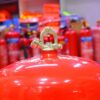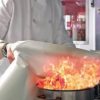- Empty cart.
- Continue Shopping
IMPORTANCE OF PROTECTIVE PERSONAL EQUIPMENT

Personal Protective Equipment as described by Occupational Safety and Health Administration (OSHA) is worn by workers so that it can protect them from dangers.
These dangers can be caused by illness or injuries that might arise due to exposure to physical, electrical, radiological, mechanical, chemicals or any other workplace hazards.
Every employee wants to feel safe in the work environment they are based in. From those working as nurse, those working in ware houses (driving a forklift), and construction sites or even in the restaurant kitchen.
Occupation Safety and Health Act requires every employer to make sure that they provide their employees with proper Personal protective equipment so that to prevent any injury that may be caused by the work hazards in the work place.
However, providing employees with these Personal Protective Equipments is not enough. Proper training is supposed to be offered to the employees about;
- What PPE they are supposed to use.
- When the PPE should be used.
- How to properly put on, adjust, wear and take off their PPE
- How to take care and dispose off their PPE.
TYPES OF PERSONAL PROTECTIVE EQUIPMENTS
The purpose of this section is making sure that it helps researchers to identify and classify various types of PPE so that appropriate safety precautions are taken while conducting a research.
There are five main types of PPEs; Hearing protection, eye protection, body protection, foot protection, hand protection and respiratory protection.
EYE AND FACE PROTECTION

Eye protection is Personal Protective Equipment and is achieved when appropriate eye wear is worn so that to protect the risk of exposure to flying debris, chemical splash as well as laser radiation.
There are several types of eye protection which includes general safety glasses, chemical splash goggles and impact goggle. Full face protection is achieved when one uses face shields.
General safety glasses.
They are supposed to have side shields or one piece of lens that wraps around the eye. They are minimum level of eye protection that is supposed to be worn in the laboratory.
Although they are not effective to protect the eye from chemical splash, they are recommended to be use with chemicals that are less likely to damage the eye such as salts and some buffers. They also have ventilation holes on the sides that protect the user susceptible to dust, chemical splashes as well as small debris.
Chemical splash goggles
They are recommended where splash from chemicals or infectious substances are likely to reach the eyes. They are recommended mostly in the construction sites so that to protect the eyes from flying debris.
Welders face shield
They are designed special for the welders. They are intended to protect a welder from the heat and optical radiation that is produced especially when cutting is being done using cutting machines that also produces sparks and debris that might act as risk to the welders’ face.
READ ALSO: WHY WEAR DUST COATS
HAND PROTECTION

Appropriate selection of gloves is essential for hand protection. Chemical protective gloves are personal protective equipment designed to protect hands from chemical exposure especially in the laboratories. Gloves are designed for different purpose and that’s why they are made of different materials, since they are designed for different tasks.
Gloves are supposed to be inspected frequently so that they can be replaced just in case they are worn out, torn or even punctured so that they can offer the maximum protection they are designed for.
Below are work gloves for hand protection
Nitrile gloves
They are designed especially for the workers who take most of their time in the working environment that is likely to expose them to chemicals. They are chemical proof as well as are resistant from punctures.
They have a feature that their surfaces are designed in a way that they are fully textured so that to enhance both wet and dry grips. They are also used while using apparatus under pressure, or water reactive chemicals
PVC Chemicals
They are made of synthetic plastic polymer which is chemical resistant. They are mostly used with workers who come in contact with corrosive liquids, organic solvents and flammable compounds. These chemicals expose workers hand to risk of hand burns and chapping. It offers protection against acids, bases, amines, peroxides as well as fats.
Cut resistant gloves
They are designed to protect the hands from cuts while working. These sharp tools include knives, sharp metals. They are perfect for handling bricks, concrete and paving.
It has latex coated palm that offers a super grip which are resistant to abrasion as well as tearing. They comply with EN 420 2003 and EN 388 2016.
Heavy duty gloves
It has genuine leather that has a hidden Velcro for desired fit, flexible, and has a vented protection over the knuckles as well as the fingers. The leather makes it durable, flexible, washable, as well as breathable.
They are advisable to the workers who work construction sites, lumber, masonry as well as welding. They are resistant to abrasion and dissipate heat. It also puncture resistant and works well as a good shock absorbent.
READ ALSO: WHY WEAR SAFETY WORK GLOVES
BODY PROTECTION

Dust coats, lab coats and work overalls are personal protective equipment are required in most of organizations. Their purpose is to properly cover workers clothes from being contaminated with stains as well as dust.
They are mostly used in the food industries, warehouse and learning institutions. They are made in different materials. Those made of cotton/poly bends are not recommended in working environment without risk of fire.
Nomex dust coats are resistant to fire, and are recommended in the working environments that involves flammable chemicals and ignition apparatus such as a burner.
Dust coats
They are loose coverall coat that reach down to the ankles and acts as a protective garment that is worn over other clothes. They are also known as lab coats and are generally used by professionals who work mostly in the laboratories. Lab cots that are used in the laboratories are used to contain the contamination in the restricted area hence preventing cross contamination to other areas.
Work Overalls
They are personal protective equipment that is worn by both men and women. It is a costume that protects individual from a number of external elements and keeps the body warm. They are used to protect the body from harmful chemicals and fires as well. Some of these work coveralls have reflectors that are used to prevent accidents especially to those who work in busy roads because it enhances their visibility.
RESPIRATORY PROTECTION

This personal protective equipment main objective is to prevent workers from exposure to contaminated air that has harmful dusts, fogs, fumes, gases, mists, smokes, vapors or sprays thus preventing illness that might result.
Individual requires assessment and training before purchasing. Proper fitting is required for effective function. There are two main types of respiratory protection.
They are air purifying respirators (APRs) and supplied air respirators (SARs) air purifying respirators can remove contaminants that are in the air by filtering out particulates.
Examples are; NP 305 chemical respirator which is a single chemical respirator and NP 306 which is a double chemical respirator.
HEARING PROTECTION

It is a Personal Protective Equipment device that is worn over the ear while exposed to hazardous noise in order to protect workers from being induced to hearing loss.
They help in reducing the noise energy reaching and causing damage to the inner ear. Most used PPE used as hearing protection are ear muffs and ear plugs
SEE ALSO: BEST BOOTS IN KENYA
CONCLUSION
In general, Personal Protective Equipment are supposed to meet the minimum requirements. These requirements are supposed to make sure that they provide adequate protection against any particular hazards for which they are designed for.
They are supposed to be of safe design, and the work which they are specialized for. They are also supposed to be comfortable when worn under designated conditions.

We Safety Hub Enterprise is a mark of quality. Your Safety Our Concern!






